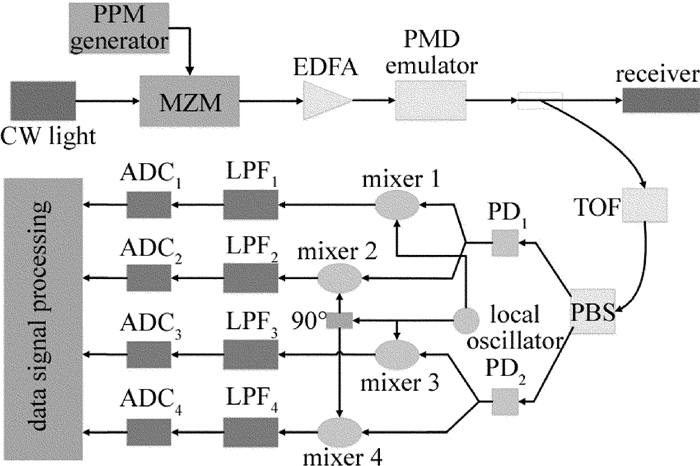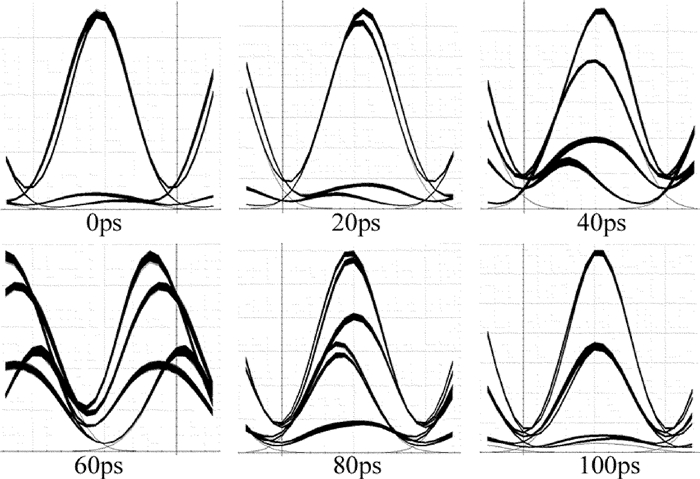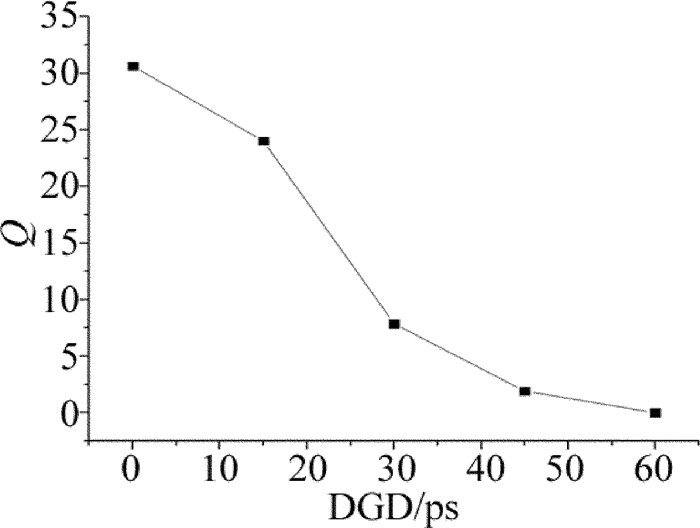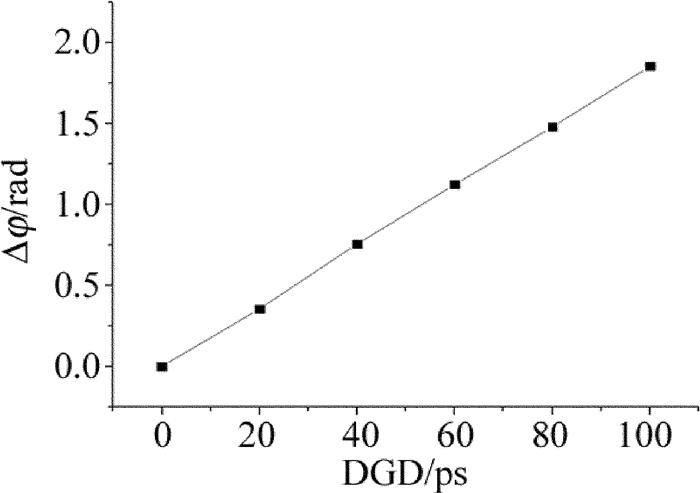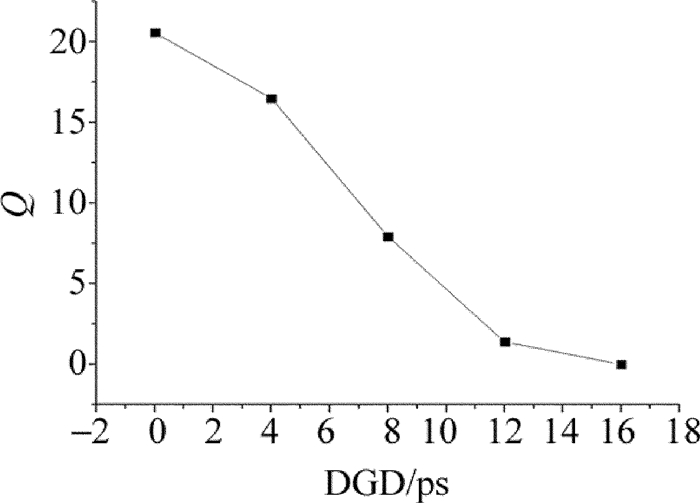Monitoring scheme of polarization mode dispersion based on pulse position modulation system
-
摘要: 为了实现对脉冲位置调制传输系统光纤信道中偏振模色散的动态监测,提出了一种新型偏振膜色散监测方案,并基于监测原理构建了数学模型。该方案基于单边带内不同偏振信号相位差实现,具有结构简单、易于实现、成本低等优点。结果表明,本方案可以实现对光信号的差分群延时与偏振态的动态监测,即当差分群延时在0ps~100ps范围内时,可准确监测;同时证实了其与信号速率关系较小,能够适应不同速率的系统,且可对脉冲位置调制传输系统的偏振模色散进行实时动态监测。该方案是一个高效可行的偏振模色散监测方案。Abstract: In order to monitor polarization mode dispersion (PMD) of the fiber communication channel in a pulse position modulation (PPM) transmission system dynamically, a novel PMD monitoring method was proposed based on single sideband polarization phase difference detection technology, and the mathematical model of the method was built in accordance with monitoring principle. The structure of the method was simple, so it can be realized easily at very low cost. The simulation results indicate that the method can realize dynamic PMD monitoring including differential group delay (DGD) and polarization state of output light, and the technique can monitor DGD accurately in the range of 0ps to 100ps. It is proved that the operation of proposed PMD monitor method is independent of data rates, which shows the proposed method can satisfy the need of real time PMD monitoring for PPM transmission systems. It indicates that the proposed method is feasible and effective for PMD monitoring.
-
-
[1] LI B. Investigation of dispersion monitoring technology for ultra-high speed optical transmission link[D].Wuhan: Huazhong University of Science and Technology, 2012: 75-102(in Chinese).
[2] ZHANG L, CHRISTEN L C, ZHANG B, et al. Polarization-mode dispersion monitoring for phase-modulated signals using DGD-genera-ted interferometric filter[J]. IEEE Photonics Technology Letters, 2008, 20(2):150-152. DOI: 10.1109/LPT.2007.912505
[3] DENG N, CHAN C K, CHEN L K. A hybrid OTDM scheme with enhanced demultiplexing performance[J]. IEEE Photonics Technology Letters, 2007, 19(19):1454-1456. DOI: 10.1109/LPT.2007.903967
[4] ZHAO J, CHEN L K, CHAN C K. A novel re-modulation scheme to achieve colorless high-speed WDM-PON with enhanced tolerance to chromatic dispersion and re-modulation misalignment[C]//Optical Fiber Communication and the National Fiber Optic Engineers Conference, 2007. New York, USA: IEEE, 2007: 1-3.
[5] LEE J H, YOSHIKANE N, TSURITANI T, et al. In-band OSNR monitoring technique based on link-by-link estimation for dynamic transparent optical networks[J]. Journal of Lightwave Technology, 2008, 26(10):1217-1225. DOI: 10.1109/JLT.2008.917060
[6] LEE J H, GUO H, TSURITANI T, et al. Field trial of all-optical networking controlled by intelligent control plane with assistance of optical performance monitors[J]. Journal of Lightwave Technology, 2009, 27(2):94-100. DOI: 10.1109/JLT.2008.928522
[7] GRUPP W. Monitoring requirements for optical transparent networks[C]//Optical Fiber Communication Conference, 2006 and the 2006 National Fiber Optic Engineers Conference. New York, USA: IEEE, 2006: OWN5.
[8] FLORIDIA C, SIMÕES G C, FERES M M, et al. Simultaneous optical signal-to-noise ratio and differential group delay monitoring based on degree of polarization measurements in optical communications systems[J]. Applied Optics, 2012, 51(17):3957-3965. DOI: 10.1364/AO.51.003957
[9] YANG J, YU C, CHENG L, et al. CD-insensitive PMD monitoring based on RF power measurement.[J]. Optics Express, 2011, 19(2):1354-1359. DOI: 10.1364/OE.19.001354
[10] BUCHALI F, BAUMERT W, BULOW H, et al. A 40Gb/s eye monitor and its application to adaptive PMD compensation[C]//Optical Fiber Communication Conference and Exhibit. New York, USA: IEEE, 2002: 202-203.
[11] LI Z, LI G. In-line performance monitoring for RZ-DPSK signals using asynchronous amplitude histogram evaluation[J]. IEEE Photonics Technology Letters, 2006, 18(3):472-474. DOI: 10.1109/LPT.2005.861968
[12] KOZICKI B, TAKUYA O, HIDEHIKO T. Optical performance monitoring of phase-modulated signals using asynchronous amplitude histogram analysis[J].Journal of Lightwave Technology, 2008, 26(10):1353-1361. DOI: 10.1109/JLT.2008.917374
[13] JARGON J A, WU X, WILLNER A E. Optical performance monitoring by use of artificial neural networks trained with parameters derived from delay-tap asynchronous sampling[C]//Optical Fiber Communication-Incudes Post Deadline Papers, 2009. New York, USA: IEEE, 2009: 1-3.
[14] HE Ch, LUO F G, LI B. Dispersion measuring technique based on second order lowest power of radio frequency signal[J]. Laser Technology, 2017, 41(2):169-173(in Chinese). http://www.en.cnki.com.cn/Article_en/CJFDTotal-JGJS201702004.htm
[15] CAO X. Optimization of dispersion compensation in optical fiber communication systems[J]. Laser Technology, 2014, 38(1):101-104(in Chinese). http://en.cnki.com.cn/Article_en/CJFDTotal-JGJS201401022.htm
[16] HU J B, LI M P. Design of novel tunable semiconductor lasers in optical fiber communication systems[J]. Laser Technology, 2016, 40(2):280-283(in Chinese). http://en.cnki.com.cn/Article_en/CJFDTOTAL-JGJS201602027.htm
-
期刊类型引用(2)
1. 沈志飞,刘晓东,费锡磊,康恺. 基于点集贝塞尔曲线优化的激光振镜加工算法. 激光技术. 2021(05): 548-553 .  本站查看
本站查看
2. 李霄,刘明. 一种钢包内壁温度场激光定位测量系统及其实验分析. 电子测量技术. 2020(05): 39-42 .  百度学术
百度学术
其他类型引用(0)




 下载:
下载:
